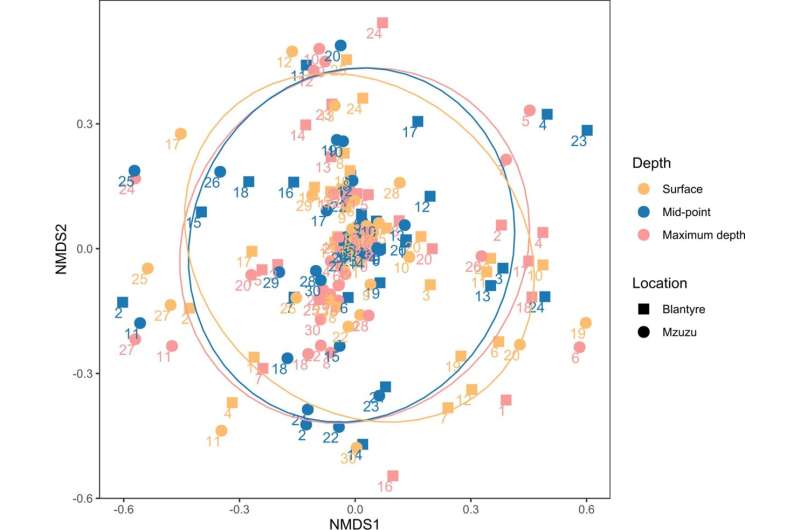This article has been reviewed according to Science X's editorial process and policies. Editors have highlighted the following attributes while ensuring the content's credibility:
fact-checked
peer-reviewed publication
trusted source
proofread
The complicated ecology of pit latrines

A new study sheds light on the complex microbial ecosystems found in pit latrines, which are used by billions of people around the world. The findings are relevant for efforts to both improve public health and reduce greenhouse gas emissions associated with global climate change.
"Properly designed and managed pit latrines are not just holes in the ground to store human waste," says Francis de los Reyes, corresponding author of a paper on the work and Glenn E. and Phyllis J. Futrell Distinguished Professor of Civil, Construction, and Environmental Engineering at North Carolina State University. "They are biological reactors that help break down the waste and reduce the likelihood that mismanaged waste will contribute to human health or environmental challenges.
"This is one of the first efforts to use genetic tools to better understand basic sanitation technologies in low-income countries," de los Reyes says. "Improving our understanding of the microbial ecosystems in these pit latrines can help us develop new management techniques that influence the behavior of those ecosystems. Those changes, in turn, could facilitate a more rapid breakdown of human waste and reduce greenhouse gas emissions."
"This work also serves as a proof of concept for using these scientific tools to monitor pit latrines for pathogens of concern," says Savanna Smith, first author of the paper and a Ph.D. student at NC State. "Essentially, we could track the pathogens in these pit latrines to inform public health interventions and reduce the likelihood of disease outbreaks."
For this study, researchers collected waste samples at three different depths from 55 lined pit latrines on the outskirts of two cities in Malawi. The researchers used genetic sequencing to identify the types of microbes present in each sample and the relative abundance of each type of microbe.
"One interesting finding was that the microbial community in any given pit stayed fairly constant, regardless of depth," Smith says. "In other words, the microbial community at the bottom of the pit was essentially identical to the community at the top of the pit.
"Also, while there was some variability from pit to pit, there was relatively little variation when you looked at all the samples together. That suggests we can draw some good general conclusions about the microbial communities of pit latrines, at least in peri-urban areas of Malawi. That's useful to know, because it can inform the development of new pit latrine management techniques in this region."
"The findings also confirm an existing hypothesis about exactly how these microbial communities break down the human waste," says de los Reyes. "Different subsets of the microbial community are more represented at different levels, with aerobic microbes more abundant near the surface and anaerobic microbes more abundant deeper in the pit. There is value here in terms of establishing experimental evidence for a longstanding hypothesis.
"But it's also valuable because it sheds light on the ways in which these microbial communities are generating methane from the human waste," de los Reyes says. "The more we understand about this process, the better able we are to develop management techniques that might hinder methane production. And that's important because methane is a potent greenhouse gas."
The researchers also tested all the samples for bacterial pathogens that are known to impact human health.
"Our findings with regard to pathogens differed from the overall findings related to microbial communities," Smith says. "There was significant variability across pits when it came to the presence and abundance of pathogens. We also found that there could be significant differences in a single pit between samples taken at different depths. These findings suggest that pit latrine monitoring could be a valuable epidemiological tool, and that you would need to sample at multiple depths to identify pathogens of concern."
The NC State team hopes to continue analyzing pit latrines and other sanitation technologies in Malawi in the future, working with collaborators in Malawi with support from the National Science Foundation.
"We hope to further show the potential of 'waste-based epidemiology,' or microbial surveillance of sanitation systems as a community pathogen monitoring tool to safeguard public health," de los Reyes says.
The paper, "Microbial Community Function and Bacterial Pathogen Composition in Pit Latrines in Peri-urban Malawi," is published in PLOS Water.
More information: Savanna K. Smith et al, Microbial community function and bacterial pathogen composition in pit latrines in peri-urban Malawi, PLOS Water (2023). DOI: 10.1371/journal.pwat.0000171
Journal information: PLOS Water
Provided by North Carolina State University





















